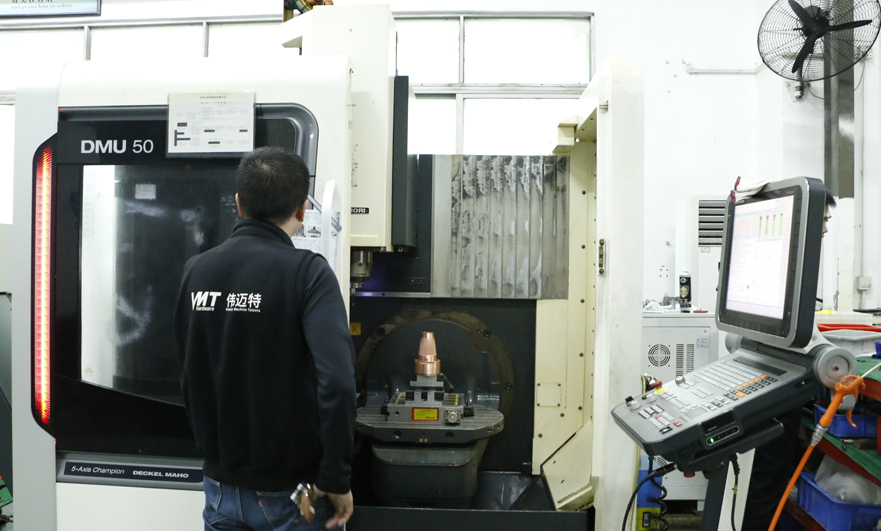15 years one-stop China custom CNC machining parts factory

Hey there I’m VMT Sam!
With 25 years of CNC machining experience we are committed to helping clients overcome 10000 complex part-processing challenges all to contribute to a better life through intelligent manufacturing. Contact us now
 184 |
Published by VMT at Dec 22 2021
184 |
Published by VMT at Dec 22 2021
The 5-axis CNC machining has high efficiency and high precision, and the workpiece can be clamped at one time. It is suitable for CNC machining of modern molds such as auto parts and aircraft structural parts. 5-axis CNC machining is not only widely used in civil industry, but also widely used in aerospace, military, scientific research, precision instruments, high-precision medical equipment and other industries. This is a high-tech method that makes the impossible possible. It can be CNC machined or produced for all spatial surfaces or unusual shapes. It can not only complete the CNC machining tasks of complex CNC machining parts and industrial products, but also quickly improve the CNC machining efficiency and shorten the CNC machining process.
5-axis CNC machining machines will help you save a lot of time in general machining centers. Most of the parts manufactured in the CNC machining workshop require five-sided CNC machining. Axial CNC milling will help complete production work quickly and efficiently. A single setup is required, which helps to save cycle time and money. Therefore, this is a cost-effective solution that speeds up the time to market for your final product.
In our CNC machining machine tool workshop, the most common and most constant-controlled stainless steel is austenitic type, such as 304 and 316. It is characterized by high work hardening rate and poor chip interruption performance during CNC machining.

Stainless steel is defined as a steel alloy with a minimum chromium content of 10.5% by mass. As the name suggests, stainless steel is a kind of steel that should be less stained and not corroded. It should be less stained, but not stain-proof. It is generally considered to be corrosion resistant, but considering the wide variety of stainless steels, this is actually not a very useful defining characteristic, because the quality and grade of stainless steel determine its strength and corrosion resistance.
The basic element in stainless steel is iron (Fe). On this basis, chromium (Cr) is added to make it a corrosion-resistant alloy, which is a mixture of metals. In order to increase the hardness and strength, a small amount of carbon (C) is usually included. Nickel (Ni) can be added to stabilize the crystalline structure of iron, thereby improving the integrity of iron at all extreme temperatures and helping to improve the corrosion resistance of iron. Other alloying elements, such as molybdenum (Mo) or titanium (Ti), can be added to improve heat and corrosion resistance.
Stainless steel usually poses greater challenges to CNC machine tools than standard carbon steel. The general rule is that the higher the alloying content of the steel, the more difficult the CNC machining. When machining stainless steel parts by CNC, it is necessary to ensure that machine vibration or tool chatter does not cause pauses or friction. In all machining processes involving cutting austenitic and duplex stainless steels, CNC work hardening is more pronounced than carbon steel or ferritic and martensitic stainless steels. While the tool life is declining, the CNC machining surface becomes harder.
304 alloy stainless steel austenitic series, containing 18% chromium and 8% nickel. The maximum carbon content of Type 304 is 0.07%. This is the standard "18/8 stainless steel", which is a common pot and cooking tool. 304 alloy is the most versatile and versatile alloy in the stainless steel family. 304 alloy has excellent corrosion resistance, easy CNC machining, and good formability after CNC machining. 304/304 L type has good formability and good welding performance. Heat treatment is not hardening. Austenitic stainless steel is also considered the most weldable high alloy steel, which can pass all fusion welding and resistance welding processes. Stainless steel work hardens quickly, heavy active feed, sharp tools, and a rigid setting, the work hardening layer under the following work hardening layer should be used.
Ready To Start Your Next Project?
Get Instant Quote

Request a Free Quote
Send us a message if you have any questions or request a quote. We will get back to you ASAP!